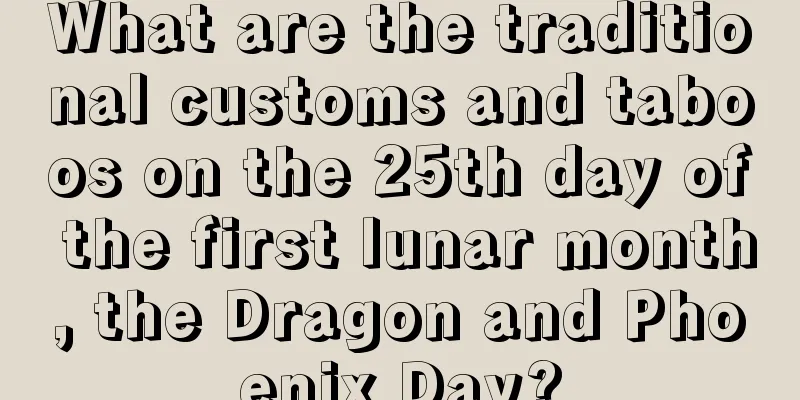What are the traditional customs and taboos on the 25th day of the first lunar month, the Dragon and Phoenix Day?

Introduction: The term "Dragon and Phoenix Day" has a history of thousands of years. Dragon and Phoenix Day is not just one day. The 25th day of the first lunar month and the 2nd day of the second lunar month when the dragon raises its head are both called "Dragon and Phoenix Day". What is “Dragon and Phoenix Day”? Are there any traditional customs and taboos on this day? Next, let’s follow the editor to learn about it! The first month of the lunar calendar is about to begin with various festivals. Let us count the important traditional festivals and customs of this month. A good year starts with spring.The 25th day of the first lunar month – Dragon and Phoenix DayThe 25th day of the first lunar month is Dragon and Phoenix Day, which is another traditional Chinese festival after the Lantern Festival in the first month of the lunar calendar. It is said to have a history of thousands of years and is still celebrated according to the old rules in the countryside. Although there are many theories about the origin of "Dragon and Phoenix Day", the Chinese people have always believed that it means "dragon and phoenix bring good luck", hoping that the new year will be good with good weather and that everything will go well in the whole year.Detailed explanation of the customs of Dragon and Phoenix Day in various parts of my countryPenglai: Dragon and Phoenix DayIn Penglai area, there are two obvious signs of celebrating the Dragon and Phoenix Day: one is that the children "wear dragon tails", that is, every household uses garlic stalks or thin sorghum stalks cut into lengths of about one centimeter, matched with colorful cloth cut into round shapes as big as copper coins, strung together with thread, and hung on the children's hats, in the hope that the children will grow up happily and healthily, and "become dragons and phoenixes" when they grow up. This custom was abolished during the Cultural Revolution, but gradually began to be restored after the reform and opening up. Although it is not very common, it is by no means uncommon in the countryside, especially in families with living elderly people. Many grandparents will "wear a dragon tail" on their grandchildren. The second is the "mixed vegetables" that every household has at noon, which is a cold dish made with cabbage hearts, vermicelli, small dried shrimps, coriander, shredded carrots, mashed garlic, vinegar, sesame oil, etc. The white, green and red are brightly colored and very appetizing. The "和" in "和菜" is pronounced as "huò" with the fourth tone in Penglai dialect. There is also a folk song in the countryside that goes "Dragon and Phoenix mix Hecai on a day, and every family will have a good time (pronounced lightly as dei)", which means "family harmony, harmony brings wealth, and life is prosperous." Jimo: Dragon and Phoenix Day Jimo calls this day the Dragon and Phoenix Day, and they use bean flour and sweet potato flour to make steamed bread, which is called Wowotou.Hebei: ChengdeThe 25th day of the first lunar month is the Granary Addition Festival, or the Dragon and Phoenix Day. In the evening before this day, people use ash to make a mark in the yard and put a little grain in the middle to indicate that the granary is full. This is called "beating the granary." Farmers still follow this festival today.Liaoning: PulandianThe Pulandian "Dragon and Phoenix Day" custom is widely distributed in the area. It falls on the 25th day of the first lunar month and has a history of more than a thousand years. "Dragon and Phoenix Day" is a comprehensive folk custom that integrates handicraft skills, traditional folk beliefs, and food culture. The rituals include: making "dragon and phoenix tails", hanging "dragon and phoenix tails" to repel insects, children wearing "dragon and phoenix tails", and eating "live vegetables". It has broad mass participation and traditional folk inheritance in the Pulandian area.Liaoning Jianping: Haladaokou TownThe 25th day of the first lunar month is Dragon and Phoenix Day, also known as "filling the warehouse." It is said that the next day is the day when the Jade Emperor and the Queen Mother meet. In order to pray for blessings, every household on earth spreads wood ash into a large circle in the yard in the morning, draws a cross in the circle, and puts a square stone slab in the center of the cross. Under the stone slab, some grains are scattered, which is called "da dun". On this day, every family eats fried rice cakes in the morning and dumplings at noon.Changchun: Eating steamed dumplingsThe family prepares beef or horse meat as filling and makes steamed dumplings. It is for the purpose of seeking good luck and predicting a good start!Summary: The above article content is what the editor wants to introduce to readers about the customs and taboos of the "Dragon and Phoenix Day" on the 25th day of the first lunar month. You can learn about it and gain more knowledge about traditional culture! After reading this article, there are more exciting contents in the special topic of the first month of the lunar calendar. Let’s take a look! |
Recommend
What zodiac sign is December 15th of the lunar calendar in 2019? Are Capricorn and Aries compatible?
What zodiac sign is December 15th of the lunar cal...
Is it good for a baby born on the sixth day of the fifth lunar month to have a good fate? What is fate?
Introduction: Although everyone cannot choose the ...
What is the five elements of a baby born on New Year’s Eve?
The five elements are gold, wood, water, fire and ...
Is it auspicious to get engaged on May 15th of the lunar calendar in 2021? Is this day suitable for engagement?
People believe that the fifth month of the lunar c...
Do people born on the day of the Frost Descent solar term in the Year of the Rat have good fortune?
Do people born on the day of the Frost Descent sol...
When is the autumnal equinox this year? How lucky or unlucky is it?
Vegetables during the White Dew and Autumnal Equin...
Is it good to give birth on the eighth day of the first lunar month in 2019? The fate of a baby born on the eighth day of the Lunar New Year
The first month of the lunar year is a time for fa...
Can I get a haircut on the ninth day of the second lunar month in 2021? Is it auspicious?
Is it possible to get a haircut on the ninth day o...
Is December 21st of the lunar calendar 2021 a good day for a haircut?
No matter who you are, if you get a haircut or cha...
What is the fate of people born in April of the lunar calendar in 2018? What are your personality traits?
Babies born in different months of 2018 have diffe...
Recommended auspicious days for moving in April 2021
There are certain time choices for moving, and not...
How about opening a new store on May 20th of the lunar calendar in 2020?
How about opening a new store on May 20th of the ...
Don’t worry about giving gifts during the Spring Festival. These mascots are the best choice!
Introduction: We Chinese have always respected the...
The lunar calendar for May 3rd in 2017. Is May 3rd a good day?
The fifth month of the lunar calendar is the Drago...
Is a child born on June 24, 2022 in the lunar calendar a Cancer?
Cancer is one of the twelve constellations. So, le...









